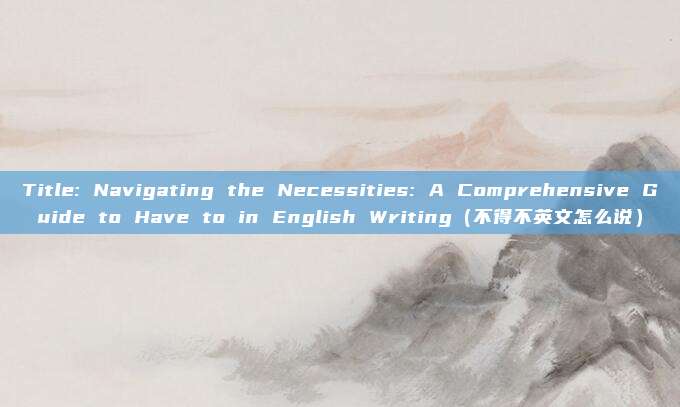Title: Navigating the Necessities: A Comprehensive Guide to Have to in English Writing(不得不英文怎么说)
温馨提示:这篇文章已超过170天没有更新,请注意相关的内容是否还可用!
Content:
Introduction:
In the world of English writing, clarity and precision are paramount. One of the most fundamental aspects of conveying meaning effectively is the use of the phrase "have to" or its synonyms. Whether you are crafting a formal business report, an engaging blog post, or a casual social media update, understanding how to utilize these expressions correctly is essential. This article delves into the intricacies of "have to" in English, offering a comprehensive guide to its usage, synonyms, and practical examples to enhance your writing.
Paragraph 1: Understanding "Have To"

The phrase "have to" is a modal verb that expresses necessity, obligation, or a feeling of being forced to do something. It is formed by combining the modal verb "have" with the infinitive form of the main verb. This structure is used to indicate that there is an external pressure or internal feeling that makes the action necessary.
Synonyms of "Have To":
To diversify your vocabulary and avoid repetition, it's helpful to know synonyms of "have to." Some common alternatives include "must," "need to," "should," "ought to," and "have got to." Each of these expressions carries a similar connotation but may be used in different contexts.
Paragraph 2: The Structure of "Have To"
The structure of "have to" is straightforward: "Subject + have/has got to + verb (infinitive)." For example, "I have to finish this report" or "She has got to leave early." This structure is consistent and easy to apply in various sentences.
Example:
In a professional setting, you might write, "We have to submit the project proposal by the end of the week." This sentence conveys the necessity of submitting the proposal without sounding overly forceful.
Paragraph 3: Using "Have To" in Different Contexts
"Have to" can be used in a variety of contexts, from formal business documents to casual conversations. Here are a few examples:
1、Formal Business Writing:
- "The company has to comply with the new health and safety regulations."
- "It has been decided that we have to implement a new marketing strategy."
2、Casual Conversations:
- "Do you have to study for the exam tomorrow?"
- "I have to finish my homework before dinner."
3、Writing for Children:
- "I have to clean my room before I can go out to play."
- "Mom says I have to brush my teeth before bed."
Paragraph 4: Avoiding Overuse and Repetition
While "have to" is a versatile phrase, overusing it can lead to monotonous writing. To avoid repetition, consider incorporating synonyms or alternative structures. For instance, instead of writing "I have to go to the store," you could say, "I need to pick up some groceries."
Conclusion:
Mastering the use of "have to" and its synonyms in English writing is a crucial skill for any writer. By understanding its structure, different contexts, and synonyms, you can enhance the clarity and effectiveness of your writing. Whether you are writing for professional or personal purposes, incorporating these expressions thoughtfully will make your work more engaging and impactful. Remember to use "have to" and its alternatives judiciously to avoid repetition and ensure your writing stands out.
网站文章、图片来源于网络,以不营利的目的分享经验知识,版权归原作者所有。如有侵权请联系删除!





还没有评论,来说两句吧...